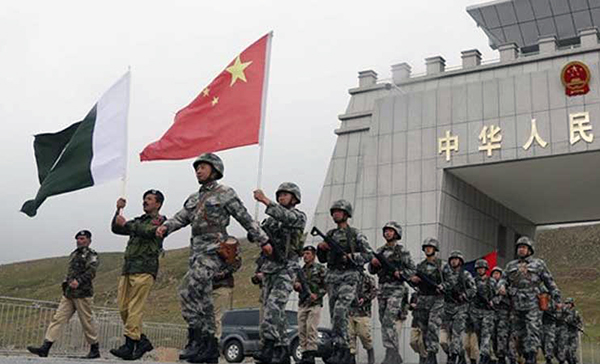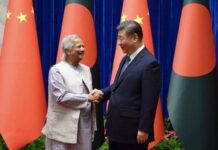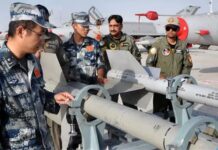
The Ukraine War has shifted attention and focus of the West, away from the Indo-Pacific, from China’s rise and the threat China poses to the existing world order.
India will have to grapple with a more belligerent China along its northern borders as a fallout of the Ukraine crisis. The Indian and Chinese armies have been locked in a border standoff since May 2020 along the Line of Actual Control (LAC) in eastern Ladakh. Since then, the two sides held several rounds of military and diplomatic which have only resulted in partial disengagement of troops from friction points.
So far, India has walked the diplomatic tightrope between the US and Russia, given its own strategic compulsions. Warding off pressure from the US and its European allies to strongly oppose Russia’s invasion of Ukraine, is a matter by itself. India hopes that purchase of the five S-400 Triumf surface-to-air missile squadrons, under the $5.43 billion (Rs 40,000 crore) contract inked with Russia in October 2018, was an “urgent national security requirement” to counter aggressive neighbours like China and Pakistan. Hence, the US will not impose sanctions under CAATSA (Countering America’s Adversaries through Sanctions Act), which seeks to prevent countries from buying Russian weapons, by mounting a major diplomatic-military campaign with both the Trump and Biden administrations.
On the China front, India will need to keep an eagle-eye on the annual exercises of the People’s Liberation Army (PLA) in March-April along the 3,488-km Line of Actual Control (LAC) and be “prepared for any contingencies.
In addition to the stalemate along the LAC, the IA could face the emergence of another front on its western flank from China’s ‘willing’ affiliate Pakistan, with the aim of dividing India’s already overstretched forces and equally strained financial and equipment resources.
As it is, the PLA has shown no signs of de-escalating the 21-month-long troop confrontation in eastern Ladakh, even as it has systematically strengthened its military positions and infrastructure all along the LAC.
With the attention of the US-led West diverted to Russia’s invasion of Ukraine instead of countering China in the Indo-Pacific, an emboldened Beijing is likely to indulge in muscle-flexing along the LAC, especially in the Arunachal sector.
Apart from conventional military capabilities, China’s focus on space, cyberspace and “informatized” and “intelligentized” warfare has been a major concern for India.
“China’s latest demonstration of physically moving one of its disabled satellites into the graveyard orbit is bringing in newer threats in the race to weaponise the space domain, a domain hitherto considered relatively safe,” IAF chief Air Chief Marshal V R Chaudhari said at a seminar on 24 February.
Quad’s Focus
Furthermore, the inchoate and nebulous preemptive deterrent instrumentality like the naval-focused Quadrilateral Security Dialogue, initiated in 2007-08 as a China-containment strategy, and one which included Australia, Japan and the US, has, in its new avatar, proven ineffectual in discouraging Beijing’s adventurism in Ladakh. Besides, all four Quad members are now preoccupied with dealing with the fallout from Ukraine’s invasion and bracing themselves for a unified China-Russia front, in which the latter’s military technology, expertise and know-how would be more aggressively mated and advanced by a financially flush and industrially forward Beijing.
India should now forcefully use its considerable diplomatic clout and its deep friendships on all sides to end the conflict and stabilise the region. The additional advantage in such a solution would be to persuade India’s strategic partners including its Quad partners to turn back their focus on China and the Indo-Pacific.
Beijing-Moscow Axis
The ongoing confusion over the war in Ukraine could impact the LAC situation, as sanctions could drive Moscow into a ‘Chinese embrace’. In that case, India would have to deal with the PLA threat by itself. And to do so it needs to summarily and significantly augment its economic and military capabilities.
India could well end up facing the brunt of this deadly security partnership between Moscow, Beijing and Islamabad. Pakistani prime minister Imran Khan’s meeting with Russian President Vladimir Putin in Moscow on February 25, within hours of the latter having ordered his army’s mobilisation against Kyiv, was ‘significant.’ It had firmly secured Putin’s eastern flank, with the exception of India, which had opted to remain neutral. It is apposite to recall that Putin lifted sanctions on Pakistan in 2014, sold it Mi-35M Hind-E attack helicopters and conducted joint exercises with its army near Peshawar in October 2018.
India’s ‘nightmare scenario’ is – Washington deciding to confront a greater threat from Russia in its European backyard than from China, and opting for a strategic accommodation with Beijing. Or the US conceding Chinese dominance in Asia to safeguard its European flank from an expansionist Russia.
India’s Options
India needs to forge long-term alliances with advanced materiel producing countries to eventually replace Russian equipment, in addition to ‘realistically’ beefing up its domestic defence manufacturing.
The government’s disjointed and ad hoc approach to fostering military capability development has to stop. The MoD needs to optimise scarce financial resources and focus on immediate security threats and not on optics, like the recent strident official announcement that Indian industry had indigenised the manufacture of assorted military-grade nuts and bolts.
Instead of half-baked measures, India must make self-reliance in military requirements a concrete national mission, along with a special thrust on space, cyberspace and special operations. Moreover, a robust nuclear deterrence is required to deter all adversaries.
The ongoing situation on northern Borders warrants the Indian Army to re-align the operational tasking of its reserve formations to focus on the northern borders and refine warfighting capabilities in high altitude mountainous terrain.
India uneasily awaits the next Chinese misadventure on its borders. Unlike Ukraine, India is alone.

















